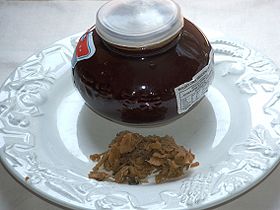Tianjin preserved vegetable
- Tianjin preserved vegetable
-

A jar of Tianjin preserved vegetable
Tianjin preserved vegetable (Chinese: 天津冬菜;; pinyin: Tiānjīn dōngcài; literally "Tianjin winter vegetable"; also called Tientsin preserved vegetable or Tianjin preserved cabbage) is a type of pickled Chinese cabbage originating in Tianjin, China. It consists of finely chopped Tianjin cabbage (箭杆菜; a variety of Chinese cabbage with an elongated shape) and salt. Garlic is also generally added in the pickling process, although it is omitted in versions prepared for consumption by members of certain Chinese Buddhist sects, who practice strict vegetarianism and do not consume garlic or other spicy foods.[1][2][3][4][5][6] This pickled vegetable is used to flavor soups, stir fried or stewed dishes.
Tianjin preserved vegetable is commercially available in earthenware crocks or clear plastic packages.
See also
References
Wikimedia Foundation.
2010.
Look at other dictionaries:
Tianjin cuisine — ( zh. 津菜 or 天津菜) is derived from the native cooking styles of the Tianjin region in China, and it is heavily influenced by Beijing cuisine. Tianjin cuisine differs from Beijing cuisine in the following ways:*Tianjin cuisine is much more heavily… … Wikipedia
preserved vegetables — Vegetable preservation dates back to Qimin yaoshu [Agricultural Techniques in Qi], China’s first encyclopedia of agriculture (531–50 AD). There is hardly a place in the country that does not produce preserved vegetables. Each has its own… … Encyclopedia of Contemporary Chinese Culture
Chinese pickles — or Chinese preserved vegetables consists of various vegetables or fruits, which have been fermented by pickling with salt and brine (鹹菜) or marinated in mixtures based on soy sauce or savory bean pastes (醬菜). The former is usually done using… … Wikipedia
Suan cai — stewed with pork and cellophane noodle is a very common dish in Northeastern China Chinese 酸 … Wikipedia
Zha cai — (literally pressed vegetable ) is a type of pickled mustard stem originating from Sichuan, China. Other transliterations might include cha tsai , tsa tsai (from Mandarin Chinese); or jar choy , jar choi , ja choi , ja choy , or cha tsoi (from… … Wikipedia
Chinese cabbage — Brassica rapa chinensis, called bok choy in the United States Details Species Brassica rapa … Wikipedia
Brassica napus — Rapeseed oil redirects here. For the vegetable oil, see canola. Rapeseed Rapeseed (Brassica napus) Scientific classification Kingdom … Wikipedia
Rutabaga — For the Drosophila gene, see Rutabaga (gene). For similar vegetables also called turnip , see Turnip (disambiguation). Rutabaga Scientific classification Kingdom … Wikipedia
Canola — For other uses, see Canola (disambiguation). Canola refers to a cultivar of either Rapeseed (Brassica napus L.) or Field Mustard (Brassica campestris L. or Brassica Rapa var.). Its seeds are used to produce edible oil suitable for consumption by… … Wikipedia
Meigan cai — A bundle of meigan cai Meigan cai (simplified Chinese: 梅干菜; traditional Chinese: 霉干菜; pinyin: méigān cài; literally molded dried vegetable ; or mei cai, 梅菜) is a type of dry pickled Chinese mustard of the Hakka people from Huizhou … Wikipedia

